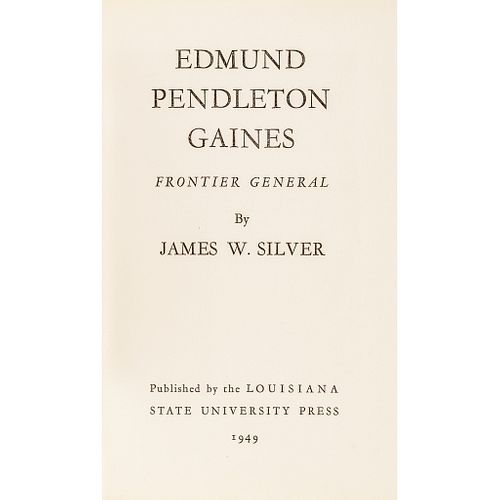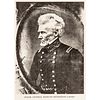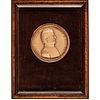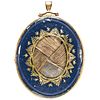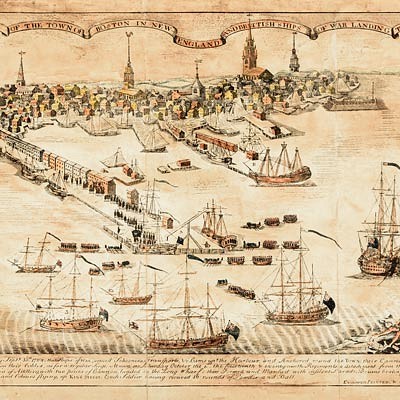Major General Edmund Pendleton Gaines Archive, Namesake of Gainesville, Florida!
Lot 33
Categories
Estimate:
$2,800 - $3,600
Absentee vs Live bid
Two ways to bid:
- Leave a max absentee bid and the platform will bid on your behalf up to your maximum bid during the live auction.
- Bid live during the auction and your bids will be submitted real-time to the auctioneer.
Bid Increments
| Price | Bid Increment |
|---|---|
| $0 | $10 |
| $200 | $20 |
| $300 | $25 |
| $500 | $50 |
| $1,000 | $100 |
| $2,000 | $200 |
| $3,000 | $250 |
| $5,000 | $500 |
| $10,000 | $1,000 |
| $20,000 | $2,000 |
| $30,000 | $2,500 |
| $50,000 | $5,000 |
| $100,000 | $10,000 |
| $200,000 | $20,000 |
| $300,000 | $25,000 |
| $500,000 | $50,000 |
About Auction
By Early American History Auctions
Mar 20, 2021
Set Reminder
2021-03-20 12:00:00
2021-03-20 12:00:00
America/New_York
Bidsquare
Bidsquare : Autographs-Colonial-Political-Americana
https://www.bidsquare.com/auctions/early-american-history-auctions/autographs-colonial-political-americana-6509
330 Lots of Rare, Historic Autographs, Americana, Civil War Era, George Washington, Abraham Lincoln, Slavery & Black History, Revolutionary War Era, Colonial America, Federal Period, War of 1812, Colonial Currency, Indian Peace Medals & more... Early American History Auctions auctions@earlyamerican.com
330 Lots of Rare, Historic Autographs, Americana, Civil War Era, George Washington, Abraham Lincoln, Slavery & Black History, Revolutionary War Era, Colonial America, Federal Period, War of 1812, Colonial Currency, Indian Peace Medals & more... Early American History Auctions auctions@earlyamerican.com
- Lot Description
Autographs
General Edmund Pendleton Gaines (1777-1849) Archive Known as the Historic Namesake of Gainesville, Florida
(EDMUND PENDLETON GAINES) (1777-1849). career United States Army officer of nearly fifty years, attaining the rank of Major General; one of the Army's Senior Commanders during its formative years early to mid-1800s; a Veteran of the War of 1812, Seminole Wars, Black Hawk War and Mexican-American War.
For his victory at the First Battle of Fort Erie during the War of 1812, Gaines was awarded with the thanks of Congress, a Congressional Gold Medal, and a brevet promotion to Major General. This Archive Collection of Four Items related to Edmund Pendleton Gaines (nothing is signed). The Gaines material was held by notable descendants of President Zachary Taylor, through his daughter Ann Mackall Taylor and her husband Richard Crooke Wood, as Gaines was a contemporary of Taylor's and a companion-in-arms. This Archive includes:
1. Hand-Painted Miniature Watercolor Portrait and Lock of Hair attributed to Gaines. Indeed, the "key" item in this lot being a colorful Hand-Painted Miniature Portrait of a young Edmund Pendleton Gaines apparently from life, dressed in his military uniform as a handsome American soldier. This Miniature Portrait is to our best knowledge previously unknown. It came with other pieces related to Edmund Pendleton Gaines who's distinguished career spanning numerous conflicts over 50 years of active service in U.S. Army military. He is also the namesake of Gainesville, Florida. The Portrait itself measures 2" x 2.5". It is not artist signed or identified, housed in a period gold locket under beveled glass. The opposite side contains a woven locket of authentic dark golden-brown hair, under beveled glass with a painted patriotic deep blue surrounding field together with 13-Stars with gold-gilt with accompanying decorative rays. We estimate the date of its production circa 1805-1812 when Gaines would be in his late 20s to around 30 years of age. There is a vertical broken crack in the painting, a result of natural warping and shrinkage, yet held together and in place by its original backing card and is worthy of conservation. Housed in its original period custom leather covered felt-lined hindged case with brass hook a top for attachment of the bezel Portrait.
2. The Portrait image does closely resemble the very Portrait of Gaines as depicted on the U. S. Mint Medal presented to Gaines for the Battle of Erie (a modern restrike example of this medal accompanies the lot).
3. Also included is a 1949 biography of Edmund Pendleton Gaines titled, "Edmund Pendleton Gaines Frontier General" by James W. Silver, 291 pages, Hardcover, Extremely Fine.
4. A simple wood framed Engraving reprint of an older Edmund Pendleton Gaines inscribed on the verso, "great, great grandmother's brother", soiling and tone. (A modern signed letter of provenance provided by a previous auction's consignor, detailing its long line of ownership provenance, will also accompany the lot.)
A number of places in the United States were named in Major General Edmund Pendleton Gaines' honor, including: Gainesvilles in Florida, Texas, Georgia, and New York; Gaines Township in Michigan; and Gainesboro in Tennessee. He was also the namesake of Gaines Streets in Tallahassee, Florida, and Davenport, Iowa; and Fort Gaines, a historic fort on Dauphin Island, Alabama. (4 items)
Edmund Pendleton Gaines (March 20, 1777 - June 6, 1849) was a career United States Army officer who served for nearly fifty years, and attained the rank of major general. He was one of the Army's senior commanders during its formative years in the early to mid-1800s, and was a veteran of the War of 1812, Seminole Wars, Black Hawk War, and Mexican-American War.
A native of Culpeper County, Virginia, he was named for his great-uncle Edmund Pendleton. Gaines was educated in Virginia and joined the Army as an ensign in 1799. He served for a year before being discharged, but returned to service in 1801 and remained in uniform until his death. In the early years of his military career, Gaines carried out important tasks including construction of a federal post road from Nashville, Tennessee to Natchez, Mississippi.
As commander of Fort Stoddert in 1807, he detained Aaron Burr, and Gaines subsequently testified at Burr's trial for treason. During the War of 1812, Gaines advanced through the ranks to colonel as commander of the 25th Infantry Regiment and he fought with distinction at the Battle of Crysler's Farm. Gaines was promoted to brigadier general during the war, and received a brevet promotion to major general.
The War of 1812 brought Gaines back to military duty and he was appointed major of the 8th Infantry Regiment. In July 1812, became lieutenant colonel in the 24th Infantry Regiment. In 1813, he was promoted to colonel and commanded the 25th Infantry Regiment with distinction at the Battle of Crysler's Farm. He became adjutant of the Army of the Northwest, commanded by General William Henry Harrison, and was with Harrison at the Battle of the Thames.
He was promoted to brigadier general on March 9, 1814 and commanded the post at Fort Erie after the U.S. capture. General Jacob Brown was wounded at the Battle of Lundy's Lane and when the Army of the Niagara returned to the fort, command was passed to Gaines. At the Siege of Fort Erie Gaines was in command on the fortifications on 15 August 1814, when a British assault was bloodily repulsed.
For this victory - the First Battle of Fort Erie - Gaines was awarded the Thanks of Congress, a Congressional Gold Medal, and a brevet promotion to major general. General Gaines was seriously wounded by artillery fire and General Brown, having recovered, returned to command. Gaines' wound ended his active field for the rest of the war, and he was given command of Military District Number 6.
Gaines' post-war service included diplomacy with and military engagements against various tribes of Native Americans, though Gaines later opposed Andrew Jackson's Indian removal policy. One of his infamous post war actions, as a General of the Federal Army, was the destruction of a fort just over the state boundary in then Spanish held Florida.
Filled with escaped slaves, this enclave was a challenge to the authority of the nearby states and slavery itself. It held over 270 people, most, if not all, blacks who had freed themselves by running away. When the fort was taken they were captured and killed (or perhaps executed. See Meacham below).
The 1828 death of Jacob Brown, the Army's senior officer, touched off a bitter feud between Gaines and Winfield Scott over which had seniority and the best claim to succeed to command. The quarrel became public and President John Quincy Adams decided to bypass both Gaines and Scott to offer the post to Alexander Macomb. When Macomb died in 1841, President John Tyler quickly headed off a rekindling of the Gaines-Scott dispute by appointing Scott as the Army's commanding general. Gaines continued to serve as a district, department and division commander, but became increasingly marginalized as Scott gained influence.
At the start of the Mexican-American War, Gaines was stationed in Louisiana and issued a public call throughout the southern and southwestern states for volunteers to join Zachary Taylor's army. He faced a court-martial for recruiting without prior authorization, but successfully defended his actions. Gaines died in New Orleans, Louisiana and was buried at Church Street Graveyard in Mobile, Alabama.
Our Auction Contents:
Black History & Slavery: (Lots 1 - 63)
Abraham Lincoln Related: (Lots 64 - 74)
Historic Autographs: (Lots 75 - 235)
Colonial America: (Lots 236 - 261)
Revolutionary War: (Lots 262 - 304)
George Washington Related: (Lots 305 - 306)
Early American Guns & Weapons: (Lots 307 - 318) - Shipping Info
-
Early American provides in-house worldwide shipping. Please contact us directly if you have questions about your specific shipping requirements.
-
- Buyer's Premium



 EUR
EUR CAD
CAD AUD
AUD GBP
GBP MXN
MXN HKD
HKD CNY
CNY MYR
MYR SEK
SEK SGD
SGD CHF
CHF THB
THB